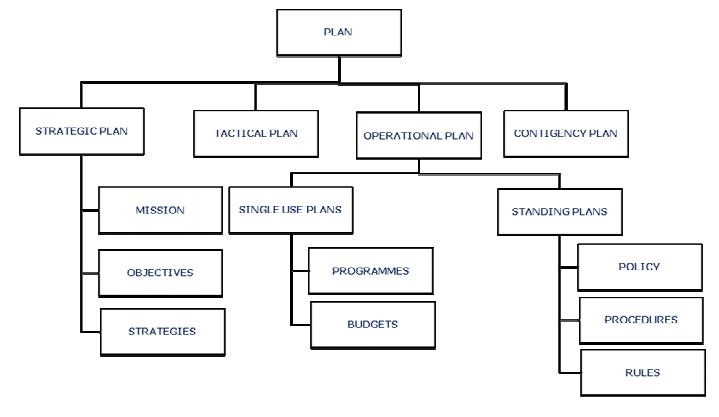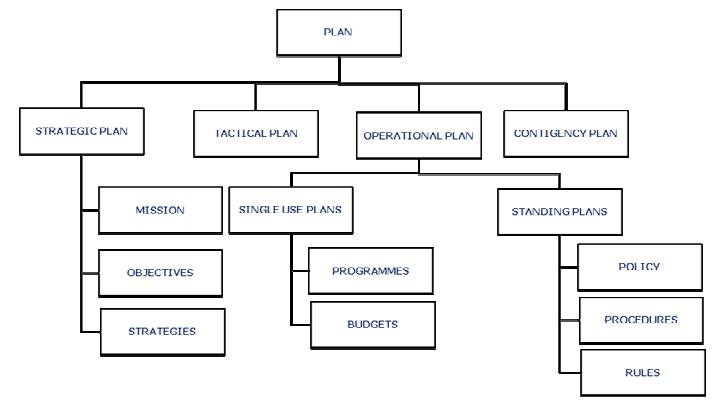Chapter: Principles of Management : Planning
Types of Plans / Components of Planning

TYPES OF PLANS / COMPONENTS OF PLANNING
In the process of planning, several plans are prepared which are known
as components of planning.

Plans can
be broadly classified as
Strategic plans
Tactical plans
Operational plans
Operational
plans lead to the achievement of tactical plans, which in turn lead to the
attainment of strategic plans. In addition to these three types of plans,
managers should also develop a contingency plan in case their original plans
fail.
a) Strategic plans:
A
strategic plan is an outline of steps designed with the goals of the entire
organization as a whole in mind, rather than with the goals of specific
divisions or departments. It is further classified as
i) Mission:
. The
mission is a statement that reflects the basic purpose and focus of the
organization which normally remain unchanged. The mission of the company is the
answer of the question : why does the organization exists?
Properly
crafted mission statements serve as filters to separate what is important from
what is not, clearly state which markets will be served and how, and
communicate a sense of intended direction to the entire organization.
Mission of
Ford: “we are a global, diverse family with a proud inheritance, providing
exceptional products and services”.
ii) Objectives or goals:
Both goal
and objective can be defined as statements that reflect the end towards which
the organization is aiming to achieve. However, there are significant
differences between the two. A goal is an abstract and general umbrella
statement, under which specific objectives can be clustered. Objectives are
statements that describe—in precise, measurable, and obtainable terms which
reflect the desired organization’s outcomes.
iii) Strategies:
Strategy
is the determination of the basic long term objectives of an organization and
the adoption of action and collection of action and allocation of resources
necessary to achieve these goals.
Strategic
planning begins with an organization's mission. Strategic plans look ahead over
the next two, three, five, or even more years to move the organization from
where it currently is to where it wants to be. Requiring multilevel
involvement, these plans demand harmony among all levels of management within
the organization. Top-level management develops the directional objectives for
the entire organization, while lower levels of management develop compatible
objectives and plans to achieve them. Top management's strategic plan for the
entire organization becomes the framework and sets dimensions for the lower
level planning.
b) Tactical plans:
A tactical plan is concerned with what the lower level units within each
division must do, how they must do it, and who is in charge at each level.
Tactics are the means needed to activate a strategy and make it work.
Tactical
plans are concerned with shorter time frames and narrower scopes than are
strategic plans. These plans usually span one year or less because they are
considered short-term goals. Long-term goals, on the other hand, can take
several years or more to accomplish. Normally, it is the middle manager's
responsibility to take the broad strategic plan and identify specific tactical
actions.
c) Operational plans
The
specific results expected from departments, work groups, and individuals are
the operational goals. These goals are precise and measurable. “Process 150
sales applications each week” or “Publish 20 books this quarter” are examples
of operational goals.
An
operational plan is one that a manager uses to accomplish his or her job
responsibilities. Supervisors, team leaders, and facilitators develop
operational plans to support tactical plans (see the next section). Operational
plans can be a single-use plan or a standing plan.
i)
Single-use plans apply to
activities that do not recur or repeat. A one-time occurrence, such as a special sales program, is a single-use plan
because it deals with the who, what, where, how, and how much of an activity.
Programme: Programme consists of an ordered list of events to be followed to execute a project.
Budget: A budget predicts sources and amounts of income and how much they are
used for a specific project.
ii)
Standing plans are
usually made once and retain their value over a period of years while undergoing periodic revisions
and updates. The following are examples of ongoing plans:
Policy: A policy provides a broad guideline for managers to follow when
dealing with important areas of
decision making. Policies are general statements that explain how a manager
should attempt to handle routine management responsibilities. Typical human resources
policies, for example, address such matters as employee hiring, terminations,
performance appraisals, pay increases, and discipline.
Procedure: A procedure is a set of step-by-step
directions that explains how activities
or tasks are to be carried out. Most organizations have procedures for
purchasing supplies and equipment, for example. This procedure usually begins
with a supervisor completing a purchasing requisition. The requisition is then
sent to the next level of management for approval. The approved requisition is
forwarded to the purchasing department. Depending on the amount of the request,
the purchasing department may place an order, or they may need to secure
quotations and/or bids for several vendors before placing the order. By defining
the steps to be taken and the order in which they are to be done, procedures
provide a standardized way of
responding to a repetitive problem.
Rule: A rule is an explicit statement that tells an employee what he or she
can and cannot do. Rules are “do”
and “don't” statements put into place to promote the safety of employees and
the uniform treatment and behavior of employees. For example, rules about
tardiness and absenteeism permit supervisors to make discipline decisions
rapidly and with a high degree of fairness.
Contingency plans
Intelligent and successful management depends upon a constant pursuit of
adaptation, flexibility, and mastery of changing conditions. Strong management
requires a “keeping all options open” approach at all times — that's where
contingency planning comes in.
Contingency
planning involves identifying alternative courses of action that can be
implemented if and when the original plan proves inadequate because of changing
circumstances.
Keep in
mind that events beyond a manager's control may cause even the most carefully
prepared alternative future scenarios to go awry. Unexpected problems and
events frequently occur. When they do, managers may need to change their plans.
Anticipating change during the planning process is best in case things don't go
as expected. Management can then develop alternatives to the existing plan and
ready them for use when and if circumstances make these alternatives
appropriate.
OBJECTIVES
Objectives may be defined as the goals which an organisation tries to
achieve. Objectives are described as the end- points of planning. According to
Koontz and O'Donnell, "an objective is a term commonly used to indicate
the end point of a management programme." Objectives constitute the
purpose of the enterprise and without them no intelligent planning can take
place.
Objectives are, therefore, the ends towards which the activities of the
enterprise are aimed. They are present not only the end-point of planning but
also the end towards which organizing, directing and controlling are aimed.
Objectives provide direction to various activities. They also serve as the
benchmark of measuring the efficiency and effectiveness of the enterprise.
Objectives make every human activity purposeful. Planning has no meaning if it
is not related to certain objectives.
Features of Objectives
The objectives must be predetermined.
A clearly defined objective provides the clear
direction for managerial effort.
Objectives must be realistic.
Objectives must be measurable.
Objectives must have social sanction.
All objectives are interconnected and mutually
supportive.
Objectives may be short-range, medium-range and
long-range.
Objectives may be constructed into a hierarchy.
Advantages of Objectives
Clear definition of objectives encourages
unified planning.
Objectives provide motivation to people in the
organization.
When the work is goal-oriented, unproductive
tasks can be avoided.
Objectives provide standards which aid in the
control of human efforts in an organization.
Objectives serve to identify the organization
and to link it to the groups upon which its existence depends.
Objectives act as a sound basis for developing
administrative controls.
Objectives contribute to the management process:
they influence the purpose of the organization, policies, personnel, leadership
as well as managerial control.
Process of Setting Objectives
Objectives
are the keystone of management planning. It is the most important task of
management. Objectives are required to be set in every area which directly and
vitally effects the survival and prosperity of the business. In the setting of
objectives, the following points should be borne in mind.
Objectives are required to be set by management
in every area which directly and vitally affects the survival and prosperity of
the business.
The objectives to be set in various areas have
to be identified.
While setting the objectives, the past performance must be reviewed,
since past performance indicates what the organization will be able to
accomplish in future.
The objectives should be set in realistic terms
i.e., the objectives to be set should be reasonable and capable of attainment.
Objectives must be consistent with one and
other.
Objectives must be set in clear-cut terms.
For the successful accomplishment of the
objectives, there should be effective communication.
Related Topics